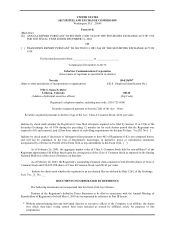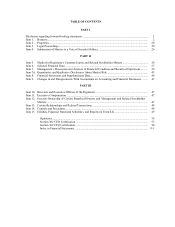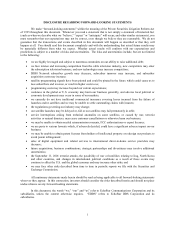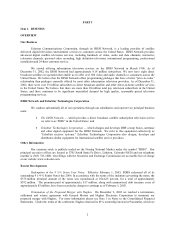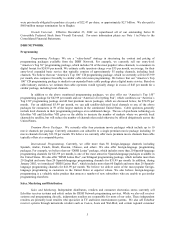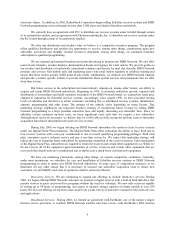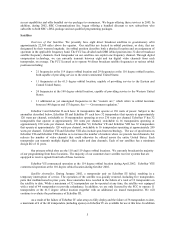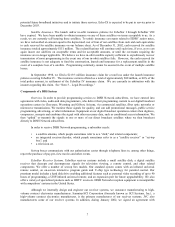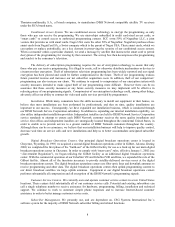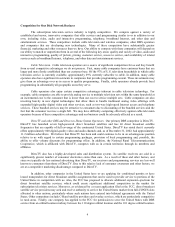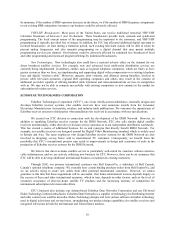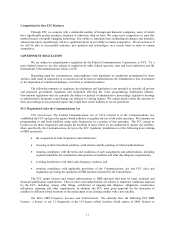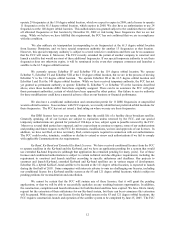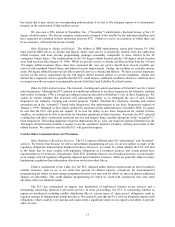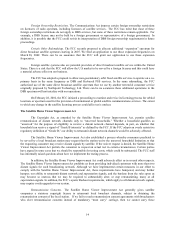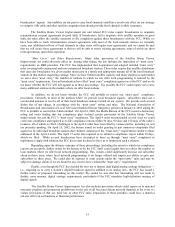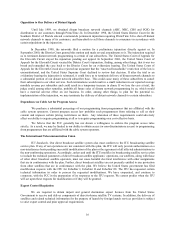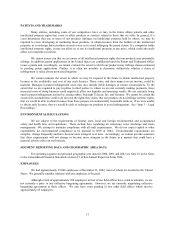Dish Network 2002 Annual Report Download - page 9
Download and view the complete annual report
Please find page 9 of the 2002 Dish Network annual report below. You can navigate through the pages in the report by either clicking on the pages listed below, or by using the keyword search tool below to find specific information within the annual report.7
potential future broadband initiatives and to initiate those services. Echo IX is expected to be put in service prior to
December 2003.
Satellite Insurance. The launch and/or in-orbit insurance policies for EchoStar I through EchoStar VIII
have expired. We have been unable to obtain insurance on any of these satellites on terms acceptable to us. As a
result, we are currently self-insuring these satellites. To satisfy insurance covenants related to EDBS’ senior notes,
we have reclassified an amount equal to the depreciated cost of four of our satellites from cash and cash equivalents
to cash reserved for satellite insurance on our balance sheet. As of December 31, 2002, cash reserved for satellite
insurance totaled approximately $151 million. The reclassifications will continue until such time, if ever, as we can
again insure our satellites on acceptable terms and for acceptable amounts, or until the covenants requiring the
insurance are no longer applicable. We believe we have in-orbit satellite capacity sufficient to expeditiously recover
transmission of most programming in the event one of our in-orbit satellites fails. However, the cash reserved for
satellite insurance is not adequate to fund the construction, launch and insurance for a replacement satellite in the
event of a complete loss of a satellite. Programming continuity cannot be assured in the event of multiple satellite
losses.
In September 1998, we filed a $219.3 million insurance claim for a total loss under the launch insurance
policies covering EchoStar IV. The insurance carriers offered us a total of approximately $88 million, or 40% of the
total policy amount, in settlement of the EchoStar IV insurance claim. We are currently in arbitration with the
insurers regarding this claim. See “Item 3 – Legal Proceedings.”
Components of a DBS System
Overview. In order to provide programming services to DISH Network subscribers, we have entered into
agreements with video, audio and data programmers, who deliver their programming content to our digital broadcast
operations centers in Cheyenne, Wyoming and Gilbert, Arizona, via commercial satellites, fiber optic networks or
microwave transmissions. We monitor those signals for quality, and can add promotional messages, public service
programming, advertising, or other information. Equipment at our digital broadcast operations centers then digitizes,
compresses, encrypts and combines the signal with other necessary data, such as conditional access information. We
then “uplink” or transmit the signals to one or more of our direct broadcast satellites where we then broadcast
directly to DISH Network subscribers.
In order to receive DISH Network programming, a subscriber needs:
• a satellite antenna, which people sometimes refer to as a “dish,” and related components;
• an integrated receiver/decoder, which people sometimes refer to as a “satellite receiver” or “set-top
box”; and
• a television set.
Set-top boxes communicate with our authorization center through telephone lines to, among other things,
report the purchase of pay-per-view movies and other events.
EchoStar Receiver Systems. EchoStar receiver systems include a small satellite dish, a digital satellite
receiver that decrypts and decompresses signals for television viewing, a remote control, and other related
components. We offer a number of set-top box models. Our standard system comes with an infrared universal
remote control, an on-screen interactive program guide and V-chip type technology for parental control. Our
premium model includes a hard disk drive enabling additional features such as personal video recording of up to 90
hours of programming, a UHF/infrared universal remote, and an expansion port for future upgradeability. We also
offer a variety of specialized products such as HDTV receivers. DISH Network reception equipment is incompatible
with competitors’ systems in the United States.
Although we internally design and engineer our receiver systems, we outsource manufacturing to high-
volume contract electronics manufacturers. Sanmina-SCI Corporation (formerly known as SCI Systems, Inc.), a
high-volume contract electronics manufacturer, is the primary manufacturer of our receiver systems. JVC also
manufacturers some of our receiver systems. In addition, during January 2002, we signed an agreement with

